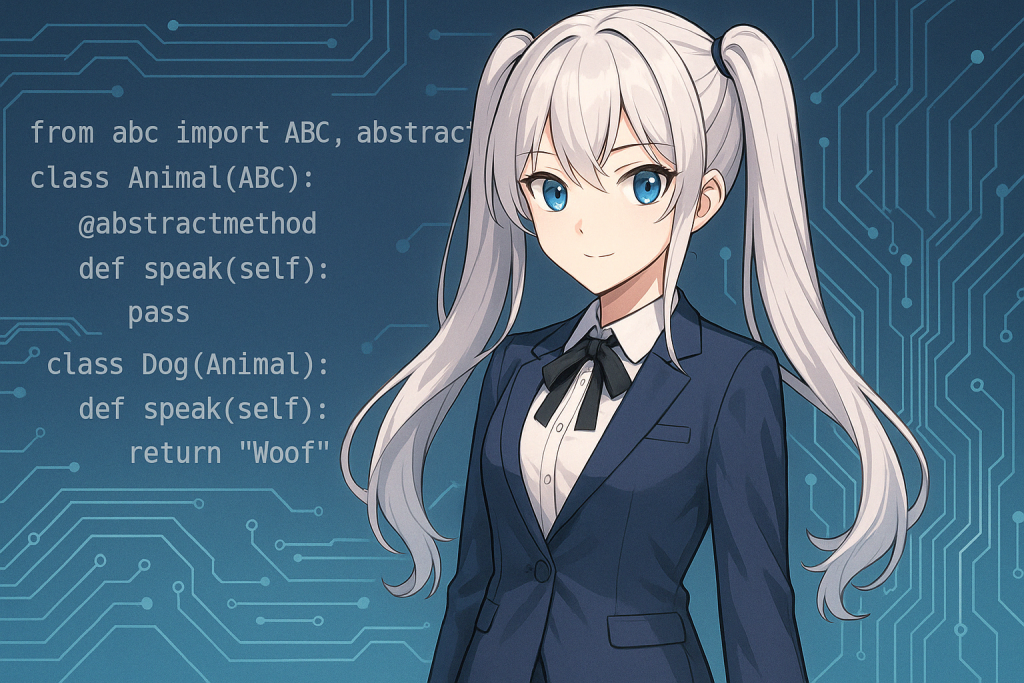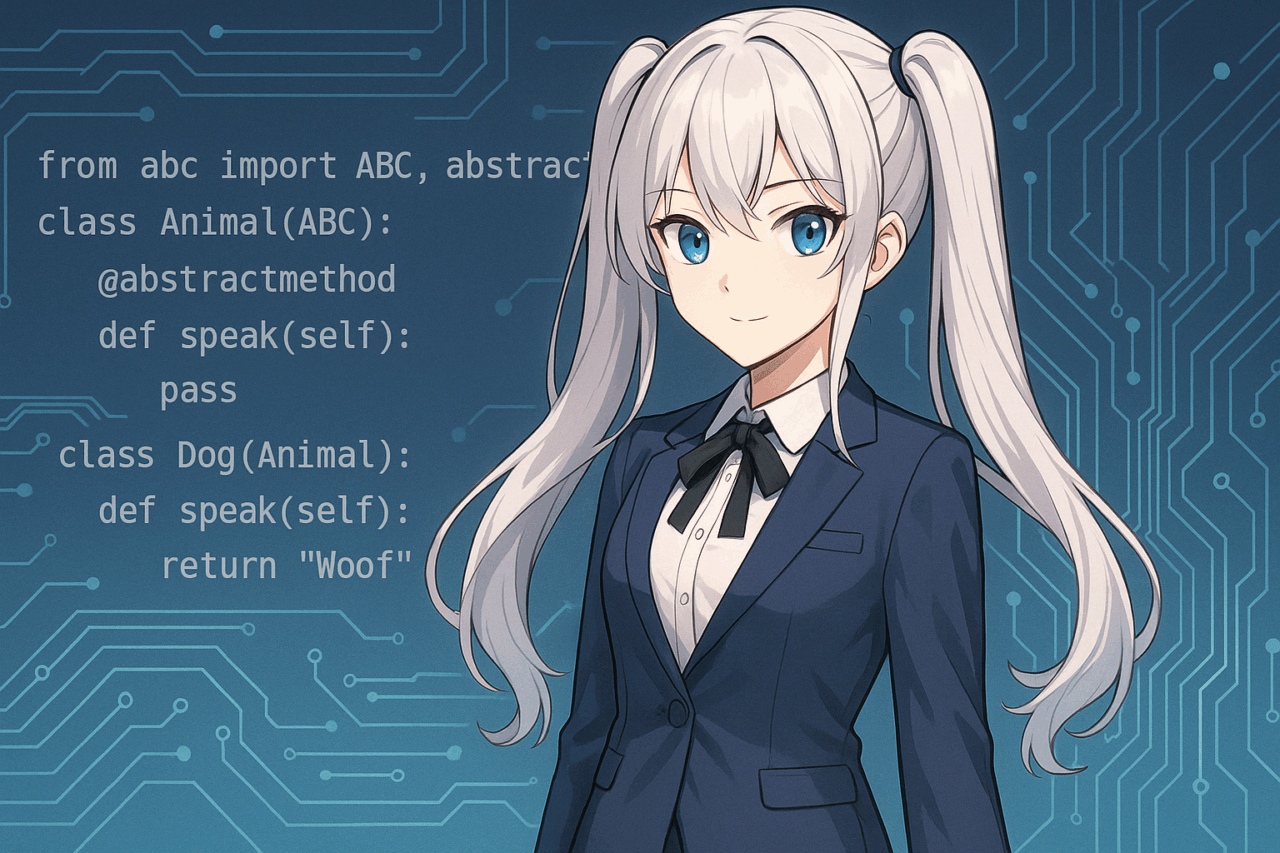- 1 1. Introduction
- 2 2. What is an Abstract Class?
- 3 3. How to Implement Abstract Classes in Python
- 4 4. Practical Example: Designing an Animal Class
- 5 5. Use Cases for Abstract Classes
- 6 5. Use Cases for Abstract Classes
- 7 6. Precautions When Using Abstract Classes
- 7.1 Strengthen Design While Being Careful Not to Overuse
- 7.1.1 1. Avoid Making the Inheritance Hierarchy Too Deep
- 7.1.2 2. Avoid Over-Abstracting Unnecessarily
- 7.1.3 3. Be Careful of Missing Implementations
- 7.1.4 4. Balance with Python as a Dynamic Language
- 7.1.5 5. Effective for Library Design and Public APIs
- 7.1.6 Proper Use Can Significantly Improve Design Quality
- 7.1 Strengthen Design While Being Careful Not to Overuse
- 8 7. Frequently Asked Questions (FAQ)
- 8.1 Organizing Key Points That Beginners to Intermediate Users Often Wonder About
- 8.1.1 Q1. What is the difference between an abstract class and an interface?
- 8.1.2 Q2. What are the benefits of abstract classes?
- 8.1.3 Q3. Can you achieve the same thing without using abstract classes?
- 8.1.4 Q4. Won’t using abstract classes make the code more complex?
- 8.1.5 Q5. Can data attributes (instance variables) also be abstracted?
- 8.1 Organizing Key Points That Beginners to Intermediate Users Often Wonder About
- 9 8. Summary
1. Introduction
The Key to Enhancing Design Skills in Python—What Are Abstract Classes?
As development using Python becomes more widespread, there is an increasing demand for code reusability, maintainability, and consistency in team development. Especially in large-scale projects, the quality of the design directly impacts the overall quality. In this context,abstract classesare one of the important concepts that elevate Python’s design capabilities to the next level.
Why Are “Abstract Classes” Gaining Attention?
In the field of program development, we face issues such as “where to consolidate common processing” and “how to ensure extensibility.” One effective approach to these is design using abstract classes. By utilizing abstract classes, it becomes possible tohave a common interface while flexibly accommodating differences in implementation.
Especially in Python, the abc (Abstract Base Class) module is provided as standard, allowing explicit definition of abstract classes. In Python, which is characterized by being “easy to write,” the appeal of abstract classes is that they can achieve both “readability” and “ease of design.”
Purpose of This Article and Target Readers
In this article, we will carefully explain everything from the basics of abstract classes in Python to practical usage, common pitfalls, and FAQs.
This is especially recommended for the following people:
- Those who know Python’s class features but don’t understand abstract classes well
- Intermediate developers interested in design patterns or clean code
- Those using Python in team development or business systems
For those who want to deepen and refine their Python development in the future, abstract classes should become an indispensable concept. Let’s start by looking at the basics together.
2. What is an Abstract Class?
Basic Concepts of Abstract Classes
Abstract classis a special class that cannot be instantiated, and it is primarily used to define a common interface (naming conventions or processing frameworks). Specific processing content is left to subclasses, while the parent class provides only that “framework.”
For example, consider a class that represents the abstract concept of “animals.” Animals have common actions such as “making sounds” or “moving,” but the details of those actions (such as a cat’s meow or a dog’s way of moving) vary by animal type. In such cases, abstract classes are very effective.
Differences Between “Abstract Classes” and “Regular Classes” in Python
In Python, regular classes can also achieve shared functionality through inheritance, but with regular classes, youcannot force subclasses to override methods. On the other hand, using abstract classes allows you to explicitly indicate the design requirement that “this method must be overridden.” This enhances theconsistency and safety of the program.
Differences Between Abstract Classes and Interfaces
A concept similar to abstract classes is “interfaces.” In other languages like Java, they are clearly distinguished, but in Python,abstract classes can also serve the role of interfaces.
The differences can be summarized simply as:
| Features | Abstract Class | Interface (Python has no explicit syntax) |
|---|---|---|
| Can include implementations | ○ | × (principally definitions only) |
| Only one inheritance source? | Multiple inheritance possible | Multiple inheritance possible |
| Can have data attributes | ○ | × (principally cannot define) |
In Python, by using the abc module, you can define abstract classes while also enabling interface-like designs.
Benefits of Using Abstract Classes
The greatest benefit of introducing abstract classes is that the “code framework” becomes clear, anticipating future extensions and maintenance. Specifically, there are the following advantages.
- When developing in a team,it becomes clear who should implement what
- Code completion and warnings from IDEs or static analysis tools become more effective
- Test design and mock creation become easier
Code completion and warnings become more effective
- Test design and mock creation become easier
3. How to Implement Abstract Classes in Python
What is the abc Module?
When implementing abstract classes in Python, use the standard library abc module (Abstract Base Classes). This module provides a mechanism to explicitly designate a class as abstract and enforce the definition of abstract methods.
Specifically, by using the ABC class and the @abstractmethod decorator, you can define that “this class is abstract and certain methods must be overridden in subclasses.”Basic Syntax for Abstract ClassesBelow is the basic way to define an abstract class in Python:
from abc import ABC, abstractmethod
class Animal(ABC):
@abstractmethod
def speak(self):
passHere, the Animal class becomes an abstract class, and the speak method is an abstract method. In this state, attempting to instantiate Animal directly raises a TypeError.
a = Animal() # Error: Can't instantiate abstract class Animal with abstract methods speakInheritance and Implementation in Subclasses
A subclass that inherits an abstract class must override all abstract methods. Below is an example:
class Dog(Animal):
def speak(self):
return "Woof woof"
dog = Dog()
print(dog.speak()) # Output: Woof woofIf even one abstract method is not implemented, the subclass itself is considered abstract and cannot be instantiated.
Differences Between ABC and ABCMeta
In Python abstract classes, you have the option to use either ABC or ABCMeta. ABC is a convenient base class with the ABCMeta metaclass already specified, and it is usually sufficient.
ABC: Can define abstract classes more concisely (recommended)ABCMeta: Can directly specify the metaclass for customization (for advanced users)
As shown below, using ABCMeta enables more flexible control:
from abc import ABCMeta, abstractmethod
class MyBase(metaclass=ABCMeta):
@abstractmethod
def do_something(self):
passHowever, in practice, inheriting from ABC is more readable and maintainable, so unless there is a special reason, it is common to use ABC.
Notes on abstractmethod
Methods marked with @abstractmethod must be overridden in subclasses. Also, the order of decorators matters. For example, when combined with @staticmethod, the order is important.
from abc import ABC, abstractmethod
class MyClass(ABC):
@staticmethod
@abstractmethod
def my_method():
passThus, in Python, defining and using abstract classes is simple yet extremely useful for achieving
robust design and high extensibility
.robust design and high extensibility is extremely useful for achieving.
4. Practical Example: Designing an Animal Class
Let’s Concretize Usage Scenarios for Abstract Classes
Up to this point, we have learned the concepts and implementation methods of abstract classes in Python. Next, to gain a deeper understanding of the usefulness of abstract classes, let’s try designing an animal class usingactual code examples.
In this example, we will base it on an abstract class called “Animal” and inherit and implement multiple animal classes (such as Dog and Cat).
Definition of the Abstract Class Animal
from abc import ABC, abstractmethod
class Animal(ABC):
@abstractmethod
def speak(self):
pass
@abstractmethod
def move(self):
passHere, we assume that all animals have actions called “speak (make a sound)” and “move (move)”. However, the content differs depending on the animal, so we define only theframework for processinghere.
Implementation of the Concrete Classes Dog and Cat
class Dog(Animal):
def speak(self):
return "Woof woof"
def move(self):
return "running"
class Cat(Animal):
def speak(self):
return "Meow"
def move(self):
return "walking gracefully"Dog and Cat inherit from Animal and specifically implement the speak and move methods. The important point here is thatboth classes override all abstract methods. If you neglect this, instantiation will not be possible.
Verification of Operation
animals = [Dog(), Cat()]
for animal in animals:
print(f"{animal.__class__.__name__} says {animal.speak()} and {animal.move()}.")Example output:
Dog says Woof woof and running.
Cat says Meow and walking gracefully.In this way, the abstract class Animal ensures acommon interface (speak and move), allowing safe and consistent processing within the for loop.

What are the Benefits of This Design?
- Improved code predictability, increasing development efficiency
- When adding new animal classes, it is easy to extend by following the abstract class structure
- During maintenance or debugging, implementation omissions become clear, allowing early error detection
This example uses the simple theme of “animals,” but inreal development environments, it can be applied to API clients, database operation classes, GUI components, and more. Abstract classes become a powerful tool that supports such structured programming.
5. Use Cases for Abstract Classes
How to Use It in the Field? Real-World Examples of Abstract Classes
Abstract classes are not just for understanding design principles; they arepart of design patterns that are useful in actual software development sites. Here, we will introduce specific scenarios where abstract classes are commonly used and examine how to effectively incorporate them into projects.
1. Designing a Group of Classes with a Common Interface
The most typical use case is when you want togive multiple similar objects common processing. Like the “animals” in the previous section, if all objects have common methods such as “speak” or “move,”processing consistency is maintained.
Example:
- A method called “process payment” common to multiple payment methods (credit card, bank transfer, electronic money, etc.)
- Authentication processing according to user permissions, etc.
By using an abstract class, you can define only the framework for each process andflexibly switch the contents.
2. Unified Interface Design for API Clients
For example, when building an application that integrates with multiple external services (Twitter API, YouTube API, etc.), you may want each API client to havecommon execution methods or authentication processing.
class APIClient(ABC):
@abstractmethod
def authenticate(self):
pass
@abstractmethod
def fetch_data(self):
passBy defining it this way, there will beno inconsistencies in the designeven for API client classes specific to each service (such as TwitterClient or YouTubeClient), greatly improving maintainability.
3. Abstraction of GUI Components
In GUI applications as well, by designing common actions for screen components such asbuttons, text, and labels (drawing or clicking, etc.)as an abstract class, you can achievereusable UI design independent of the platform.
class Widget(ABC):
@abstractmethod
def draw(self):
pass
@abstractmethod
def on_click(self):
passThis way, even if you switch to a different framework in the future (for example, migrating from Tkinter to PyQt), you can respond without disrupting the basic design.
4. Advantageous for Unit Testing and Mock Creation
Designs composed of abstract classes also have the advantage ofmaking it easy to prepare mock objects during testing. If you generate mocks from the abstract class for objects that the class under test depends on,the flexibility and reliability of tests improve.
For example:
class DummyPaymentGateway(PaymentGateway):
def process(self):
return "Dummy processing completed"This kind of design is highly compatible with TDD (Test-Driven Development) and CI (Continuous Integration), and isa technology that supports the foundation of large-scale development.
For Writing “Clear and Readable Code” Required in Practice
Abstract classes serve not only the purpose of “writing highly reusable code” but also asa design guideline for making code resilient to future changes and easy for others to read.
They should not be introduced into all classes immediately, but in the initial design stages or when considering extensibility, abstract classes become strong allies.
5. Use Cases for Abstract Classes
How to Use It in the Field? Real-World Examples of Abstract Classes
Abstract classes go beyond just understanding design principles; they formpart of design patterns that are practical in real-world software development. Here, we’ll specifically introduce common scenarios where abstract classes are used and explore how to effectively incorporate them into projects.
1. Designing Groups of Classes with Common Interfaces
The most typical use case is when you want togive multiple similar objects common processing. Like the “animals” in the previous section, if all objects have common methods like “speak” or “move,”consistency in processing is maintained.
Example:
- A “process payment” method common to multiple payment methods (credit card, bank transfer, electronic money, etc.)
- Authentication processing according to user permissions, etc.
By using abstract classes, you can define only the framework for each process andflexibly switch the contents.
2. Unified Interface Design for API Clients
For example, when building an application that integrates with multiple external services (Twitter API, YouTube API, etc.), you often want each API client to havecommon execution methods and authentication processing.
class APIClient(ABC):
@abstractmethod
def authenticate(self):
pass
@abstractmethod
def fetch_data(self):
passBy defining it this way, even for API client classes specific to each service (TwitterClient or YouTubeClient, etc.), there will beno inconsistencies in the design, greatly improving maintainability.
3. Abstraction of GUI Components
In GUI applications as well, by designing an abstract class forcommon actions of screen components like buttons, text, and labels (drawing, clicking, etc.), you can achievereusable UI design independent of the platform.
class Widget(ABC):
@abstractmethod
def draw(self):
pass
@abstractmethod
def on_click(self):
passThis way, even if you switch to a different framework in the future (for example, from Tkinter to PyQt), you can respond without disrupting the basic design.
4. Also Beneficial for Unit Testing and Mock Creation
Designs composed with abstract classes also have the advantage ofmaking it easy to prepare mock objects during testing. By generating mocks from the abstract class for objects that the test target class depends on,the flexibility and reliability of tests improve.
For example:
class DummyPaymentGateway(PaymentGateway):
def process(self):
return "Dummy processing completed"Such designs are highly compatible with TDD (Test-Driven Development) and CI (Continuous Integration) and aretechnologies that support the foundation of large-scale development.
For Writing “Clear and Readable Code” Required in Practice
Abstract classes serve not only the purpose of “writing highly reusable code” but also asdesign guidelines for creating code that is resilient to future changes and easy for others to read.
It’s not something you should immediately introduce to all classes, but in the initial stages of design or when considering extensibility, abstract classes become strong allies.
6. Precautions When Using Abstract Classes
Strengthen Design While Being Careful Not to Overuse
Abstract classes are a very convenient mechanism in design, but they arenot a panacea. If you introduce them in the wrong situations or use them incorrectly, it can actually harm maintainability or slow down development. This section explains the key points and precautions to keep in mind when using abstract classes in Python.
1. Avoid Making the Inheritance Hierarchy Too Deep
Overusing abstract classes naturally tends to make theinheritance hierarchy deeper. For example, going from abstract class → intermediate abstract class → concrete class… and so on, adding layers makes it harder to trace the code.
Inheritance is a powerful mechanism, but if it getstoo deep, it can lead to a state where “it’s unclear what each class is doing”. In general, it’s ideal to keep thedepth of inheritance to 2-3 levels or fewer.
2. Avoid Over-Abstracting Unnecessarily
It’s common during early development to define abstract classes assuming “this feature might expand in the future.” However, if they end up unused and left as is, it canincrease the project’s complexity with unnecessary abstraction.
Abstract classes should naturally be introduced when “common processing or structure is already visible across multiple classes.” A practical approach is toavoid over-anticipating and first build with concrete classes, then abstract as needed.
3. Be Careful of Missing Implementations
If you forget to implement an abstract method, the subclass remains an abstract class, andan exception occurs during instantiation.
TypeError: Can't instantiate abstract class MyClass with abstract methods do_somethingThis is an intentional safety feature in Python, but for beginners, the error message can be hard to understand, and they mightmistake it for a bug.
Therefore, when introducing abstract classes, it’s important toclearly document the class structure and inheritance relationships.
4. Balance with Python as a Dynamic Language
Python is originally a dynamic language based on“duck typing,” allowing designs that work without abstract classes. So, if you overuse abstract classes with the same mindset as statically typed languages (like Java or C++), it can lead toredundant designs.
To preserve Python’s essence, it’s best tolimit abstract classes to situations where strictness is necessary. In particular, in cases like the following, protocols or simple duck typing may feel more natural than abstract classes:
- Lightweight tools or scripts
- Small-scale projects or validation code
5. Effective for Library Design and Public APIs
On the other hand, abstract classes are highly effective forlibraries or plugin designs exposed to external users. They serve as acontractto indicate to developers “implement it with this structure.”
In this case, abstract classes simplyformalize design guidelines, improving the library’s quality and making the API easier to use for third-party developers.
Proper Use Can Significantly Improve Design Quality
Abstract classes carry the risk of rigidifying designs if misused, but when used appropriately, they are apowerful tool that enhances the consistency and maintainability of the entire project.
Once you can judge “whether this is a situation to use them” and “whether now is the right timing,” your Python skills will level up another notch.
7. Frequently Asked Questions (FAQ)
Organizing Key Points That Beginners to Intermediate Users Often Wonder About
As your knowledge of Python’s abstract classes deepens, specific questions like “What does this mean?” or “Can this be used in this case?” may also arise. In this section, we’ve compiled frequently asked questions in Q&A format.
Q1. What is the difference between an abstract class and an interface?
A1.Python does not have a dedicated syntax for “interfaces” like Java or C#, but you can achieve interface-like designs using abstract classes.
Interfaces typically only define methods (without implementations), but abstract classes allow some methods to share common implementations. In other words, Python’s abstract classes offer more flexibility than interfaces.
Q2. What are the benefits of abstract classes?
A2.The main benefits are the following three points:
- Explicitly Stating Design Intent: You can clearly indicate in the code that “this method must be implemented.”
- Reusing Common Processing: Since some common processing can be implemented in the abstract class, it reduces the amount of code in subclasses.
- Preventing Errors: Classes that do not implement required methods cannot be instantiated, which helps detect design oversights early.
Q3. Can you achieve the same thing without using abstract classes?
A3.Theoretically, yes. Since Python is a dynamically typed language, a common approach is duck typing, where you assume “this class should have this method” and use it accordingly.
However, if you prioritize code reliability, readability, and clear agreements in team development, designing with abstract classes is better. The benefits of abstract classes become even greater as the project scale increases.
Q4. Won’t using abstract classes make the code more complex?
A4.If used incorrectly, that possibility exists. Excessive abstraction or unnecessary inheritance can actually make the code harder to understand.
Abstract classes are best limited to cases where “there are multiple similar classes with common behaviors,” which organizes the design and improves development efficiency. Introduce them only when the need is clear.
Q5. Can data attributes (instance variables) also be abstracted?
A5.In Python’s abstract classes, only abstract methods are enforced. There is no syntax to abstract data attributes (e.g., self.name), but you can define rules in abstract methods like “this variable should be used.”
If you want to ensure the presence of attributes, you can achieve this by combining properties (@property) with abstract methods.
from abc import ABC, abstractmethod
class MyBase(ABC):
@property
@abstractmethod
def name(self):
passThis way, you can treat the presence of attributes as part of the interface.
8. Summary
Abstract Classes Are Powerful Tools That Provide the “Skeleton” for Design
In this article, we have explained step by step from the basic concepts of abstract classes in Python to implementation methods, practical code examples, usage scenarios, precautions, and common questions.
The essence of abstract classes is to explicitly indicate the functions and structures that all classes should have. This improves the overall visibility of the code and functions as a “common language for design” in large-scale applications or team development.
Reviewing the Key Points of This Article
- What Are Abstract Classes: Classes for design that cannot be instantiated directly. They define a common interface.
- Implementation Method in Python: Use the
abcmodule, and define by combiningABCand@abstractmethod. - Specific Usage: Can be applied to animal classes or API clients, etc., to enhance code consistency and maintainability.
- Precautions: Need to consider excessive abstraction, overly deep inheritance hierarchies, balance with dynamic languages, etc.
- Supplements in FAQ: Addresses questions that beginners are likely to have, supporting flexible understanding.
How to Connect to Future Learning
Abstract classes are one of the unavoidable topics in enhancing design skills in object-oriented programming. By combining with the following learning and practices, deeper understanding and application become possible.
- Learn the Relationship Between Inheritance and Polymorphism
- Understanding Design Patterns (Especially the Template Method Pattern)
- Integration with Unit Testing and Mock Design
- Understanding SOLID Principles, Such as the Interface Segregation Principle (ISP)
Abstract classes are not just one technique, but also “design thinking” for efficiently and high-quality advancing future development.
In Conclusion
Because Python is a simple and easy-to-write language, beginners tend not to focus on “design.” However, precisely because of that, taking a step forward and being conscious of
“why design it this way” “how to structure it”
is the first step to making a big difference from other Python engineers.
Please try using abstract classes in your own project once. Your perspective on design will surely change.





